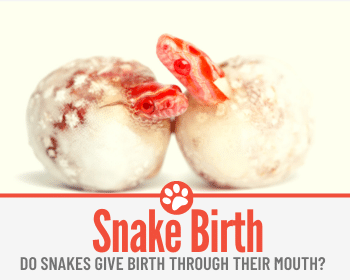 Snakes are weird animals; they move by pushing their scales along the ground with their muscles. without limbs or legs of any sort.
Snakes are weird animals; they move by pushing their scales along the ground with their muscles. without limbs or legs of any sort.
How do snakes give birth, since they seem to do a lot of things differently from other animals?
Apart from some rare lizard species, snakes are the only reptiles that do not have any legs, limbs or appendages to aid their movement, so it is conceivable that they give birth to their offspring in an unusual way, right?
Do snakes give birth through their mouth?
Snakes do not give birth through their mouth. I know snakes can be really weird and can even pull off surprising tricks with their mouths, like spewing venom or swallowing food far bigger than its small head, but giving birth to their young ones will blow the weird-o-meter completely out of the water!
Where do Snake Eggs Come From
Snakes are reptiles and like reptiles, most snakes produce their young ones by laying soft leathery eggs, that hatch into baby snakes. How do snakes lay these eggs?
Snakes, birds and other reptiles have an opening near their tails from which they excrete or urinate. That opening also known as the cloaca is how snakes lay their eggs.
Do Snakes Lay Eggs in the Ground
Yes, they do. After mating, most female snakes will lay their eggs usually in the shallow holes in the ground. Sometimes, the snakes will just lay their eggs inside hollow logs. Basically, any place that is warm and loose enough for hatched baby snakes to easily crawl out from. Usually, it’s in loose soil or sand.
How Does the Snake Give Birth
A male snake will usually mate with a female if it follows the scent the female creates when it is ready to mate. Sometimes, the male will have a mock fight with other male snakes. The winning male gets to mate.
After mating, the female snake will develop eggs or in some cases, snake “fetus” or snakelets as they’re formally called. It takes between 1 – 2 months for the snake to be ready to give birth.
When the snake is ready to give birth, it will lay the eggs or give birth to snakelets through an opening near the tail (the cloaca) that doubles as both a waste-removing organ and a reproductive organ. Snakes usually give birth in clutches or groups. Depending on the species, a snake can give birth to more than 100 snakes at once!
One interesting fact about female snakes, which is probably unique to them, is their special ability to “chose” whether it get pregnant or not. Because of this, a snake can mate once and decide when it is ready to give birth!
Usually, when a snake gives birth, it doesn’t really care for its young snake-babies. It leaves then almost immediately. In fact, most types of snakes like coral snakes will lay their eggs and quietly slither off! Very few snakes, usually pythons and king cobras will guard and warm their eggs until it hatches.
Do snakes lay eggs or give live birth?
While most snakes give birth by laying eggs which hatch into baby snakes, some snakes can give birth without laying any eggs at all. There are actually three ways which snakes give birth. So, it’s not really even a “Do snakes lay eggs or give live birth?” question, because snake birth is a bit more complicated.
1. Oviparous Birth
The first and most common way snakes give birth is by laying eggs. This method is formally called Oviparous birth. Oviparous birth is commonly associated with birds and reptiles, so, it’s not a very unusual form of birth for snakes. The key difference between snake eggs and bird eggs is the hardness of the shell. Snakes have a much softer shell.
About 70% of snakes are oviparous and they tend to live in warmer parts of the world.
2. Viviparous Birth
Around 20% of snakes give birth to their babies alive. Snakes like green anacondas and boa constrictors are very good examples of viviparous snakes. Viviparous birth is exactly how humans and many mammals give birth.
Viviparous snake-birth resembles how humans give birth where the fetus is connected to their mother through the placenta and a yolk sac. Viviparous snakes like the green anaconda can give birth to a large number of snakes at one time.
3. Ovoviviparous Birth
As if giving birth through two different ways is not enough, some snakes add another layer (needless really – in my opinion) by giving birth through eggs without laying the eggs.
Ovoviviparous birth is not very common among snakes. It’s really as it sounds, a cross between simply laying eggs and walking away (oviparous birth) and giving birth to live snakes and walking away.
Rather than that, ovoviviparous snakes give birth by laying eggs and only the eggs do not come out of the cloaca. Instead, the eggs remain inside the oviduct and continue to develop there until it is ready to hatch and start its own life.
Snakes are not the only ovoviviparous animals though, other animals that give birth this way include guppies, some sharks and fishes like ray fishes.
There’s still a lot of disagreement about “ovoviviparity”. Some scientists do not think it is very different from giving birth to live animals.
Why are Snakes Ovoviviparous?
Snakes that usually lay eggs tend to live in warm regions. Some species that lay eggs, however, live in cold regions. Garter snakes and pit vipers are one example of ovoviviparous snakes.
The temperature of snakes is regulated by the environment. That is why snakes tend to hibernate during cold weather and are more active in hot periods.
Some people think that some snakes are ovoviviparous because the environment is too cold for their eggs to hatch. So, the mother keeps them inside, where the conditions are better suited for hatching.
Can Snakes Give Birth Without Eggs?
Snakes in general, do not give birth in one way, or two for that matter. As we’ve seen some snakes can give birth to their offspring alive, or lay eggs and even without necessarily laying the eggs (ovoviviparous birth).
The factors that determine how a snake will give birth range from what part of the world it is living and the temperature there, to what type of snake it is.
For example, most female snakes living in hot tropical parts give birth by laying eggs. You will find out that as you move away from the equator towards colder regions, the number of egg-laying snake species decreases. As you go further north, you will see more live-bearing snakes.
The only snake specie that lives in the frigid temperature of the arctic zone is the European viper (also called European adder). Unsurprisingly, it gives birth to its offspring alive.
Do Snakes Give Live Birth Through Their Mouth
Short answer, no. It is a common misconception that snakes can lay eggs or give birth to live snakelets from their mouth. It’s not true. Some fishes and the now-extinct Australian Platypus frog do give live birth through their mouths, but snakes have not been able to pull off that trick yet.
Do Baby Snakes Stay with Their Mothers
Many snakes are notoriously careless about their babies. Most will simply lay the eggs and slither off; some snakes will protect their eggs until they hatch. A few like the king cobra will actually build nests for their young and pit vipers and African rock pythons will remain with their young until they shed the first skin.
References Used:
- “Snakes: Egg Formation and Laying” Encyclopaedia Britannica https://www.britannica.com/animal/snake/Egg-formation-and-laying
-
- Paretts Susan, “What Are the Two Types of Egg Births in Snakes” Pets on Mom.com https://animals.mom.me/two-types-egg-births-snakes-11116.html
- “Viviparity” Wikipedia: the free encyclopaedia https://en.wikipedia.org/wiki/Viviparity
- Schmackpfeffer Mallory, “Snake Reproduction” High Trails https://dirtyclassroom.com/snake-reproduction-mallory-schmackpfeffer/#fnref-14988-2






